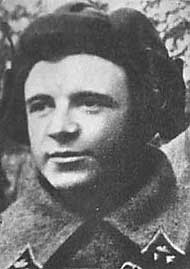Dmitri Feodorovich Lavrinenko
Dmitri Fyodorowitsch Lavrinenko ( Russian Дмитрий Фёдорович Лавриненко ; born September 10, 1914 in Besstraschnaja near Jekaterinodar ; † December 18, 1941 in Moscow Oblast ) was a Soviet T-34 tank commander during World War II . He was honored as a Hero of the Soviet Union because of his achievements in the fight against the German Wehrmacht .
Lavrinenko initially worked as a teacher and volunteered for the Red Army in 1934 . After a year in the cavalry , he went to the tank school in Ulyanovsk , where he completed his training in 1938. After operations against Poland in September 1939 (Ukrainian Front) and Bessarabia in 1940, he received a command in the 15th Panzer Division in 1941 with the invasion of German troops . During the Battle of Moscow , he served in the 4th Tank Brigade. He commanded a T-34 /76, which was superior to the best tank of the Wehrmacht at the time, the Panzer IV , in terms of firepower and armor.
He achieved his first three tank kills in the vicinity of Oryol and Mtsensk . In October 1941, Lavrinenko was assigned 16 tanks in a single battle. He was last shot down on the day of his death, December 18, 1941 near Wolokolamsk .
With a total of 52 kills, more than twice as many as the next best Red Army soldier, Dmitri Lavrinenko is described as the most successful Allied tank gunner of World War II. Not only battle tanks are counted, but all types of armored vehicles (see list of Wehrmacht tracked vehicles ), which he eliminated in his 28 fights. This also includes guns on self-propelled guns such as the Sturmgeschütz III at that time , as well as armored personnel carriers such as Sd.Kfz. 250 and Sd.Kfz. 251 .
Dmitri Lavrinenko was killed in defense of Moscow in General Ivan Panfilov's division in 1941 . Posthumously he received the Order of Lenin . It was not until 1985 that he was awarded the highest Soviet Order of Hero in the Soviet Union .
Lavrinenko is regarded as an example of the possibility of avoiding the initially high Soviet losses caused by the sometimes incorrect use of tanks through correct leadership.
Individual evidence
Web links
- The best Soviet tank gunners in War is over (English, also Russian)
- Article in Украинская баннерная сеть (Russian)
| personal data | |
|---|---|
| SURNAME | Lavrinenko, Dmitri Fyodorovich |
| ALTERNATIVE NAMES | Lavrinenko, Dmitrij Födorovitsch; Лавриненко, Дмитрий Фёдорович (Russian); Lavrinenko, Dimitri |
| BRIEF DESCRIPTION | Soviet T-34 tank commander |
| DATE OF BIRTH | September 10, 1914 |
| PLACE OF BIRTH | Besstraschnaya near Ekaterinodar |
| DATE OF DEATH | December 18, 1941 |
| Place of death | Moscow Oblast |
